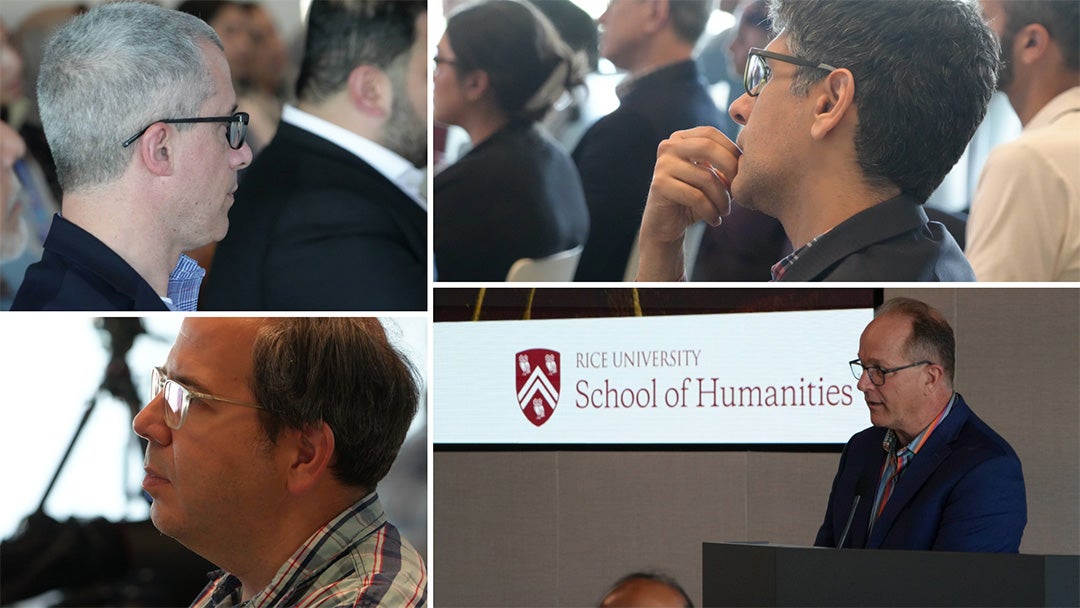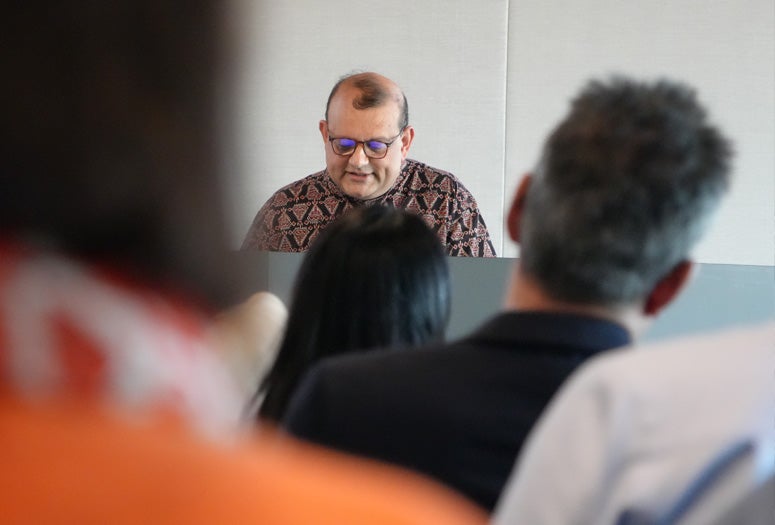
The story of Karbala has reverberated across centuries and continents. In his 2025 Kazimi Lecture in Shi’i Studies held April 14 at Rice University, scholar Syed Akbar Hyder turned the spotlight toward a key force behind the story’s legacy and transmission largely overlooked: its women and the way they mourn.
Hosted by the School of Humanities, the annual Kazimi Lecture honors the memory of Syed Safdar and Samina Kazimi by inviting artists and scholars whose work deepens understanding of Shi’i Islam. Hyder’s talk “Making History in Mourning: Resistance, Resilience and Risks of the Karbala Collective” explored the gendered, interfaith and aesthetic dimensions of mourning the Battle of Karbala through cultural art forms that evolved across South Asia, focusing on the elegiac genre of the Urdu marsiyah. Through these poetic laments for Karbala’s martyrs, Hyder traced how mourning practices became powerful sites of memory and cultural production shaped by the agency and moral complexity of the female perspectives featured in the Karbala narrative.
Figures like Zainab, the sister of Imam Hussain who delivered defiant speeches after Karbala, and Hind, the wife of Yazid whose role complicates narratives of grief and power, were central to Hyder’s exploration of embodied grief, moral witness and ethical action.
“Strong women in this tradition set examples of caretaking as much as they do of ethical engagement with those who have fewer resources and less power than they do,” said Hyder, director of the South Asia Institute at the University of Texas at Austin.
The marsiyah, Hyder said, is far more than a poetic tradition. It has been instrumental in connecting personal loss to communal resistance, drawing on layered histories of colonization, religious reform and literary competition. Poets such as Mir Anis and Mirza Dabir turned devotional grief into literary brilliance, infusing their work with humanity that transcended sectarian lines. Yet “the most earnest admirers of the marsiyah often forget that this form of writing received patronage from women,” Hyder said.

In addition to its patrons and protagonists, the form’s melodrama and emotionally heightened performance led critics to discount it as a “feminine” and therefore undignified and inferior genre. But this collective performance of mourning was also a democratic force, connecting the most elite writers with those who could not read and the royal courts with everyday households. Hyder emphasized that women were not only patrons and poets but also educators and caretakers of memory who taught lessons of justice and mercy through lived example.
“These lessons from the Prophet’s family are not supposed to go unheeded,” Hyder said. “The devotees and servants of this family are expected to internalize them and implement them just as the character from the marsiyah world does.”
Hyder went on to place the women of the marsiyah in conversation with a more contemporary female voice: Qurratulain Hyder. Although the celebrated Urdu writer is widely known for her monumental 1959 novel “Aag ka Darya,” Syed Akbar Hyder’s new book “Qurratulain Hyder on the Move” invites readers to expand their engagement with her literary vision through her lesser-known reportage pieces. Drawing from this work, Syed Akbar Hyder steered his discussion of the marsiyah into an analysis of Qurratulain Hyder’s genre-defying “Qaid-khane men talatum hai keh Hind ati hai (Tumult rises in prison, for Hind approaches),” a modern literary text that the author described as ʿālam āshob: a world of turmoil, a prison where grief becomes a mode of resistance as well as an invitation to cultivate solidarity.
Written in Urdu but infused with fragments of English and Persian, this text brimming with poetic allusion both mourns and interrogates the world of nation-states and 24-hour news cycles where our shared humanity must be gathered and reassembled from the scraps of grief and beauty we find in the fog of propaganda, distortion and distraction. In the ʿālam āshob, the marsiyah shines through as a guide to assembling this grief, though it too comes to us in fragments as the narrative jumps between the Karbala story and dystopian events occurring under more modern but unnamed oppressive regimes.
As Hyder moved through the ʿālam āshob during his lecture, he highlighted its ethical demands. The text challenges readers to abandon the safety of spectatorship and instead enter the grief of others, recognizing complicity and calling for solidarity.
“We sit in front of our televisions, cold and aloof as Gabriel, perhaps watching the world’s misfortunes and passion plays unfold,” Hyder said.
But in the process of mourning, Hyder argued, lies the possibility of transformation — not just for individuals but for communities willing to carry the burdens of the past to shape a more just future. This is the truth laid bare by Qurratulain Hyder’s literary vision, which pierced through superficial categories of religion, language and nation-state and which Syed Akbar Hyder compared to the “third eye” of Sufi tradition.

Hyder’s lecture returned repeatedly to Karbala not as a fixed location in history but as a living ethical paradigm — one that could be evoked to honor figures as wide-ranging as Gandhi and Martin Luther King Jr. and one that continues to speak to the oppressed and displaced across time.
The music of mourning, literal and metaphorical, was never far from his reflections. Hyder cited the work of his former student and now an established scholar of comparative devotional literature, Peter Knapczyk, who discovered that 18th-century manuscripts paired marsiyah poetry with specific ragas, underscoring the aesthetic sophistication of devotional expression.
“These accounts are important in light of a centuries-old debate over music’s permissibility for pious Muslims,” Hyder said, while highlighting how in Qurratulain Hyder’s work the plurality of expressions of mourning reminds us that facile, mutually exclusive categories of faith, devotion, nation and language should be located in ever-shifting contexts of histories and geographies.
For Syed Akbar Hyder, both the traditional marsiyah of Dabir and the modern ʿālam āshob of Qurratulain Hyder are genres of witnessing. He identifies them as literary and performative spaces where victims can speak and where listeners are challenged not to consume tragedy but to feel and act on it — not by rushing toward vengeance and other “masculine” feats of strength but by cultivating community within the stillness of one’s loss as so many women and children must do when war and injustice destroy all other witnesses.
“History requires a form, a legibility protocol, not only to be read and understood but also to be made,” Hyder said. “These are the stories we tell ourselves in order to live, to wage war or make peace, to rise up against injustice or fall in line.”
Karbala has provided many such forms and legibility protocols to people over the generations. Today, they may come to us partially broken or obscured by history, by modern politics or technology, by ignorance or erasure, Hyder says, but the grief they carry still has the power to make us whole should we choose, as Hind did, to step into the prison and cry with those trapped inside.
“Mourning, like poetry, is the communication between hearts,” Hyder said. “When prose fails, mourning defies any one form of expression.”

